South Dakota mule deer guides offer expertise, local knowledge, and proven strategies to enhance hunting success, ensuring a safe and memorable experience for both novice and experienced hunters.
1.1 Overview of Mule Deer Hunting in South Dakota
South Dakota offers exceptional mule deer hunting opportunities, with a mix of public and private lands providing diverse habitats for these elusive creatures. The state’s vast prairies, rolling hills, and rugged terrain create challenging yet rewarding hunting conditions. Mule deer are known for their impressive antlers and cautious nature, making them a prized target for hunters. Seasonal regulations, bag limits, and habitat preservation efforts ensure sustainable populations. Hunters often rely on guides to navigate the landscape, identify prime locations, and maximize their chances of success. This combination of natural beauty and abundant wildlife makes South Dakota a premier destination for mule deer enthusiasts.
1.2 Importance of Guides for Successful Hunts
Hiring experienced South Dakota mule deer guides significantly enhances hunting success. Guides possess intimate knowledge of local habitats, deer behavior, and seasonal patterns, ensuring hunters are in the right place at the right time. They handle logistics, from securing permits to navigating challenging terrain, allowing hunters to focus on the hunt. Guides also provide expertise in tracking, stalking, and calling, increasing the likelihood of a successful harvest. Their familiarity with private land access and public areas maximizes hunting opportunities. Additionally, guides prioritize safety and ethical practices, making them indispensable for both novice and seasoned hunters seeking a productive and memorable experience.
Understanding Mule Deer Habitat in South Dakota
South Dakota’s mule deer thrive in diverse habitats, including rolling prairies, forested hills, and rugged terrain, with elevation and vegetation playing critical roles in their survival and movement.
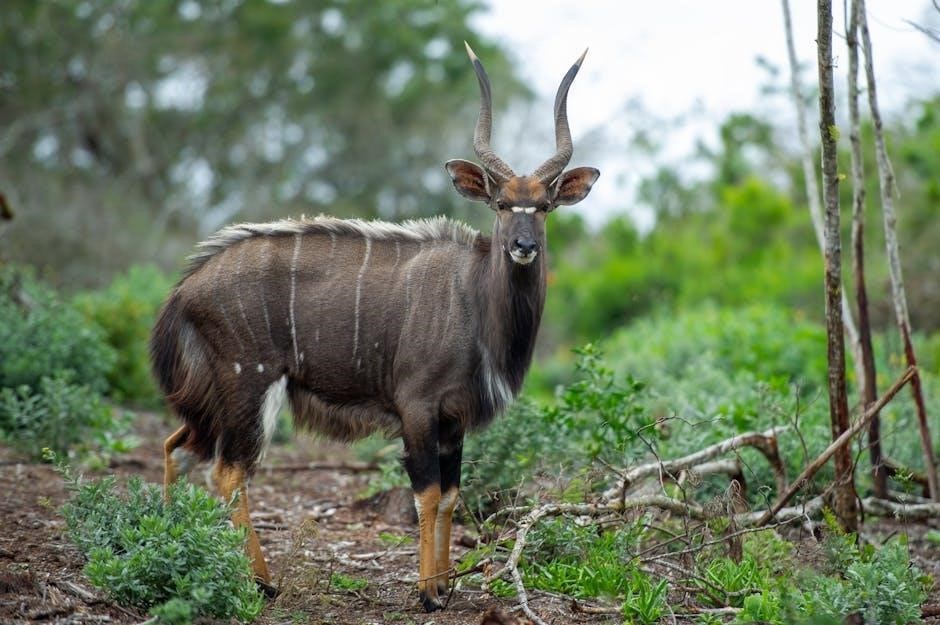
2.1 Geographic Regions for Mule Deer
South Dakota’s mule deer primarily inhabit the western and central regions, where habitats are more conducive to their survival. The Black Hills provide dense forests and rugged terrain, ideal for mule deer to thrive. Meanwhile, the prairie regions offer open spaces with abundant food sources. The Badlands, with their unique rock formations, serve as a crucial habitat for mule deer during different seasons. These geographic regions are not only vital for mule deer but also attract hunters seeking diverse landscapes and challenging terrain. Guides often focus on these areas to maximize hunting success, leveraging their deep knowledge of local habitats and deer behavior.
2.2 Types of Terrain and Elevation
South Dakota’s mule deer habitats vary significantly by terrain and elevation, influencing deer behavior and movement patterns. Forested areas, such as those in the Black Hills, provide cover and shade, while open prairies offer abundant forage. Rocky outcroppings and canyons serve as escape routes and ambush points for deer. Elevation plays a key role, with mule deer often moving to higher elevations during summer and descending to lower areas during winter. Understanding these terrain types and elevation changes is crucial for effective hunting strategies, as guides use this knowledge to locate and track deer efficiently across diverse landscapes.
2.3 Role of Vegetation in Deer Movement
Vegetation plays a critical role in mule deer movement and behavior in South Dakota. Deer rely on grasses, shrubs, and trees for food and cover, with different vegetation types influencing their daily and seasonal movements. Areas with dense cover, such as cedar thickets or riparian zones, provide hiding spots, while open fields and meadows offer feeding grounds. Guides understand how vegetation patterns dictate deer movement, allowing them to predict where deer will feed, rest, and travel. This knowledge is essential for setting up effective hunting strategies and ambush points, ensuring hunters are in the right place at the right time.
Licensing and Regulations for Mule Deer Hunting
Licensing requirements vary for residents and non-residents, with specific tags allocated through a draw system. Season dates and bag limits are strictly regulated to ensure sustainability.
3.1 Licensing Requirements for Residents and Non-Residents
Obtaining a valid South Dakota hunting license is essential for mule deer hunting. Residents must provide proof of residency, while non-residents face higher fees and limited tag availability. Applications for licenses and tags are submitted through the South Dakota Game, Fish, and Parks (GFP) department, with strict deadlines. Non-residents often participate in a draw system, requiring preference points to increase chances of securing a tag. Additional permits, such as habitat stamps, may be mandatory. Ensuring compliance with all licensing regulations is critical to avoid penalties and ensure a legal hunt.
3.2 Tag Allocation Process and Draw System
South Dakota’s mule deer tags are allocated through a draw system, with applications typically submitted by non-residents in May and residents in June. Preference points, earned by applying unsuccessfully in previous years, increase chances of securing a tag. The South Dakota Game, Fish, and Parks (GFP) department manages the draw, prioritizing applicants with higher points. Tags are limited to maintain herd health, making the process competitive, especially for prime hunting units. Applicants must carefully select units based on availability and their point status. Deadlines are strict, and only successful applicants are notified, ensuring fairness and transparency in the allocation process.
3.3 Season Dates and Bag Limits
South Dakota’s mule deer hunting seasons are carefully structured to align with deer activity and conservation goals. Rifle seasons typically run from mid-October to early November, with archery and muzzleloader seasons offering earlier opportunities. Bag limits are strictly enforced, usually allowing one buck per hunter, while antlerless permits are limited to specific units. Resident and non-resident hunters must adhere to these regulations, which are designed to maintain a balanced deer population. Hunters are urged to consult the South Dakota Game, Fish, and Parks (GFP) for the most accurate and up-to-date season dates and bag limit information before planning their hunt.

Best Times for Mule Deer Hunting in South Dakota
South Dakota’s mule deer hunting seasons typically occur from September to November, with peak rutting in late October. Weather conditions play a significant role in deer activity and hunting success.
4.1 Peak Rutting Season and Activity
The peak rutting season for mule deer in South Dakota typically occurs in late October, with bucks actively seeking does during this period. This time offers heightened activity, as males engage in territorial displays and vocalizations. Hunters can capitalize on this behavior by focusing on areas with high doe concentrations. The rutting phase significantly increases the chances of spotting trophy bucks, making it a prime time for harvesting. Weather conditions, such as mild temperatures and light winds, can further enhance deer movement, while harsh weather may reduce activity. Understanding these patterns is crucial for a successful hunt during the rut.
4.2 Early and Late Season Strategies
Early season mule deer hunting in South Dakota focuses on exploiting deer patterns before the rut, often targeting food sources and water. Hunters use spot-and-stalk tactics in open terrains, while late-season strategies shift to ambush points near bedding areas and thermal cover. During the late season, deer prioritize survival, making them less active and more predictable. Understanding these behavioral changes is key to success. Weather conditions, such as cold snaps and snow cover, can further concentrate deer, creating opportunities for patient hunters. Adapting strategies to these seasonal shifts enhances the likelihood of a successful harvest.
4.3 Weather Conditions and Their Impact
Weather plays a crucial role in mule deer hunting success in South Dakota. Rain and snow can reduce visibility and alter deer movement, pushing them to lower elevations or thicker cover. Wind impacts scent dispersion, making it harder for deer to detect hunters but also challenging for hunters to remain undetected. Extreme cold increases deer reliance on food sources, concentrating them in feeding areas. Warm spells during late season can delay deer activity, making early morning and late evening hunts more productive. Understanding and adapting to these conditions is essential for effective strategies, as weather significantly influences deer behavior and hunting outcomes.
Essential Gear for Mule Deer Hunting
Rifles, high-quality optics, durable clothing, scent control products, and reliable backpacking gear are crucial for navigating South Dakota’s challenging terrain and unpredictable weather conditions during mule deer hunts.
5.1 Firearms and Optics Recommendations
For mule deer hunting in South Dakota, a reliable rifle with a flat trajectory, such as a .270 Winchester or .300 Winchester Magnum, is ideal for long-range shots. High-quality optics, including binoculars (7x or 8x magnification) and a riflescope with adjustable zoom, are essential for spotting and tracking deer in open terrain. Consider waterproof and fog-proof optics for durability in varying weather conditions. A rangefinder is also crucial for accurate distance measurement, ensuring ethical and precise shots. Properly sighting in your rifle and practicing with your optics are key to maximizing effectiveness in the field.
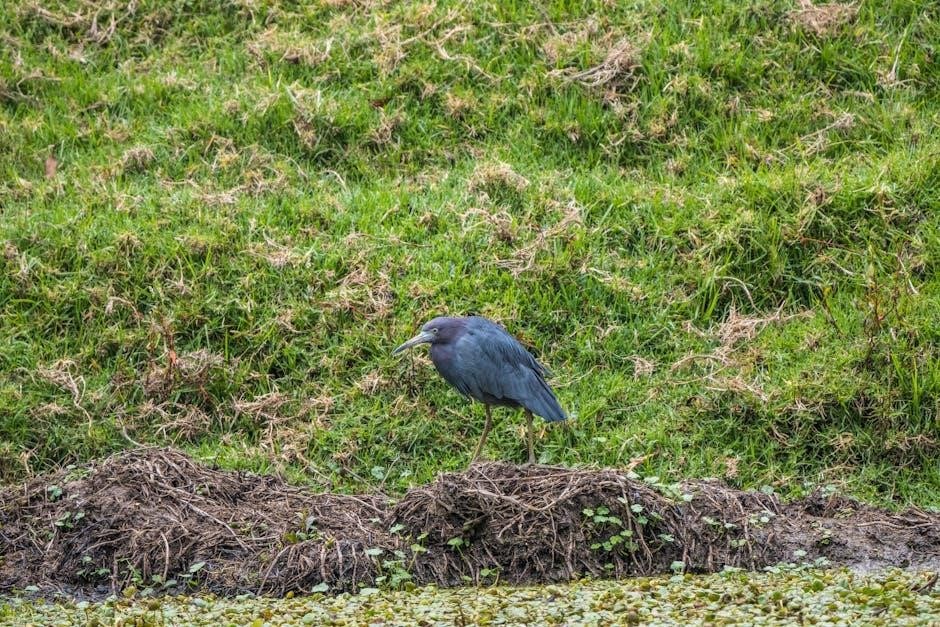
5.2 Clothing and Scent Control
Proper clothing is vital for mule deer hunting in South Dakota’s varied climate. Layering with breathable, moisture-wicking fabrics like merino wool and waterproof outerwear ensures comfort in cold and wet conditions. Camouflage patterns help hunters blend into the terrain. For scent control, hunters should use scent-blocking clothing treated with odor-reducing technology. Additionally, scent-eliminating sprays and washing clothes in unscented detergent can minimize human scent. Staying clean and avoiding strong-smelling foods or perfumes further reduces the risk of spooking deer. These practices enhance stealth, increasing the chances of a successful hunt in South Dakota’s vast hunting grounds.
5.3 Backpacking and Field Gear
Backpacking and field gear are essential for mule deer hunting in South Dakota’s rugged terrain. A sturdy, comfortable backpack with multiple compartments ensures easy access to supplies. Durable materials like nylon or canvas are recommended for withstanding harsh conditions. Navigation tools such as a compass and GPS device are crucial for tracking locations. Hydration systems, like water filters or collapsible water bottles, help manage water intake. A first aid kit, multi-tool, and extra batteries for optics are must-haves. Lightweight, weather-resistant gear is ideal for long treks, while scent-control sprays and game bags prepare for field dressing. Properly organized gear enhances mobility and efficiency during the hunt.
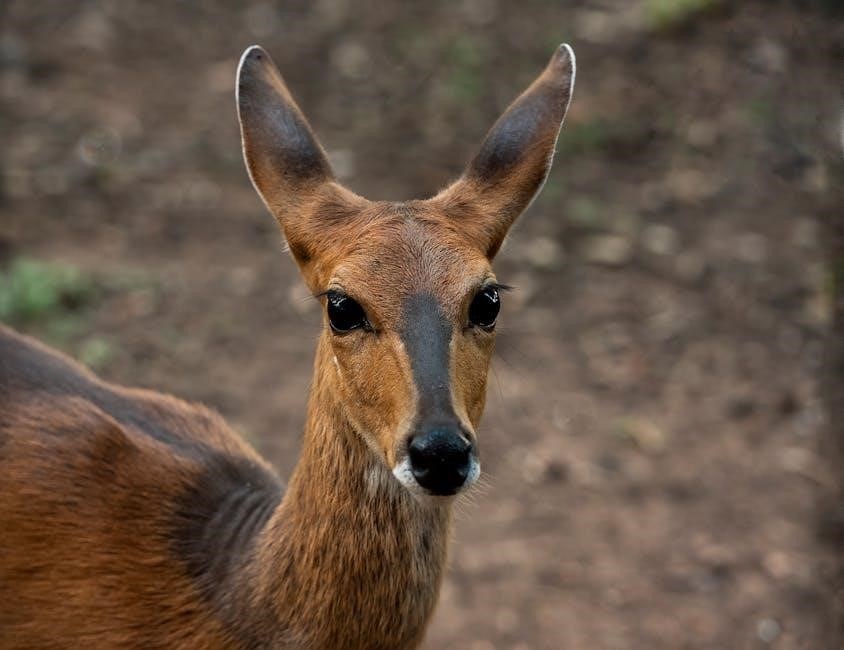
Techniques for Hunting Mule Deer
Effective spot-and-stalk tactics, strategic calling, and utilizing ambush points are key techniques for mule deer hunting in South Dakota, requiring patience, skill, and knowledge of terrain and deer behavior.
6.1 Spot-and-Stalk Tactics
Spot-and-stalk hunting is a thrilling method requiring patience and skill. Guides use high-quality optics to locate mule deer in open terrain, then lead hunters in a stealthy approach. Understanding deer behavior, terrain, and wind direction is crucial. Hunters must move quietly, staying low and using cover like rocks or brush. Camouflage clothing and scent control enhance effectiveness. Physical fitness is essential due to the potential for long hikes. Guides often pre-scout areas, increasing the likelihood of successful encounters. This tactic demands precision and calm, making it a rewarding experience for those willing to invest time and effort into mastering the strategy.
6.2 Calling Strategies
Calling strategies are a dynamic approach to attract mule deer, particularly during the rut. Guides often use a combination of grunt calls, bleats, and rattling to mimic deer vocalizations. These sounds can lure curious bucks or does into range. Timing is critical, as calls are most effective during peak rutting periods when deer are actively seeking mates. Guides may also use fawn distress calls to attract does, which can lead to encountering larger bucks. While calling requires skill and subtlety, it can be an effective way to engage deer and create opportunities for a successful hunt in South Dakota’s diverse terrain.
6.3 Ambush Points and Stand Locations
Ambush points and stand locations are crucial for intercepting mule deer movement. Guides identify high-traffic areas like trails, ridges, and feeding grounds to set up stands. Elevation and cover are key factors, as deer often move between feeding and bedding areas. Stands are positioned to capitalize on wind direction and visibility, ensuring hunters remain concealed. Early morning and late evening are prime times for ambushes, as deer are most active. Guides use their knowledge of terrain and deer behavior to select stand locations that maximize opportunities for a clean shot, making ambush tactics a reliable method for successful mule deer hunting in South Dakota.
Role of Guides in Mule Deer Hunting
Guides provide crucial expertise, ensuring hunters maximize their success by offering local knowledge, strategic planning, and access to prime hunting locations, enhancing overall hunting efficiency and safety.
7.1 Local Knowledge and Experience
Experienced South Dakota mule deer guides possess extensive local knowledge, enabling them to navigate diverse terrains, identify prime habitats, and predict deer movement patterns. Their deep understanding of the region’s ecosystems, gained through years of hunting and exploration, allows for strategic placement of hunters in high-probability areas. Guides familiar with private land access and public hunting grounds maximize opportunities, ensuring hunters make the most of their time. This expertise significantly enhances the likelihood of a successful hunt, making local guides invaluable for both novice and seasoned hunters seeking to harvest trophy mule deer in South Dakota’s challenging yet rewarding landscape.
7.2 Pre-Scouting and Trail Camera Use
Pre-scouting is a critical component of successful mule deer hunting in South Dakota, allowing guides to identify active deer habitats and movement patterns. Trail cameras are extensively used to monitor buck activity, track feeding areas, and determine travel corridors. This intel enables guides to plan strategic hunting routes and ambush points, maximizing the likelihood of encountering trophy deer. By analyzing camera footage, guides can adapt to changing deer behavior and weather conditions, ensuring hunters are positioned in the most productive locations. This proactive approach significantly enhances the efficiency and success of mule deer hunting expeditions in South Dakota’s diverse landscapes.
7.3 Physical Conditioning and Safety
Physical conditioning is crucial for mule deer hunting in South Dakota’s rugged terrain, requiring guides and hunters to be in top shape for long hikes and elevation changes. Guides emphasize the importance of stamina, as hunts often involve climbing steep hills or traversing vast prairies. Safety is a priority, with guides ensuring clients are prepared for unpredictable weather and potential hazards like rough terrain or wildlife encounters. Proper gear, first aid kits, and emergency communication devices are essential. Guides also assess clients’ physical limitations to tailor the hunt, ensuring a safe and enjoyable experience. Their expertise in navigating challenging landscapes further enhances safety and success.
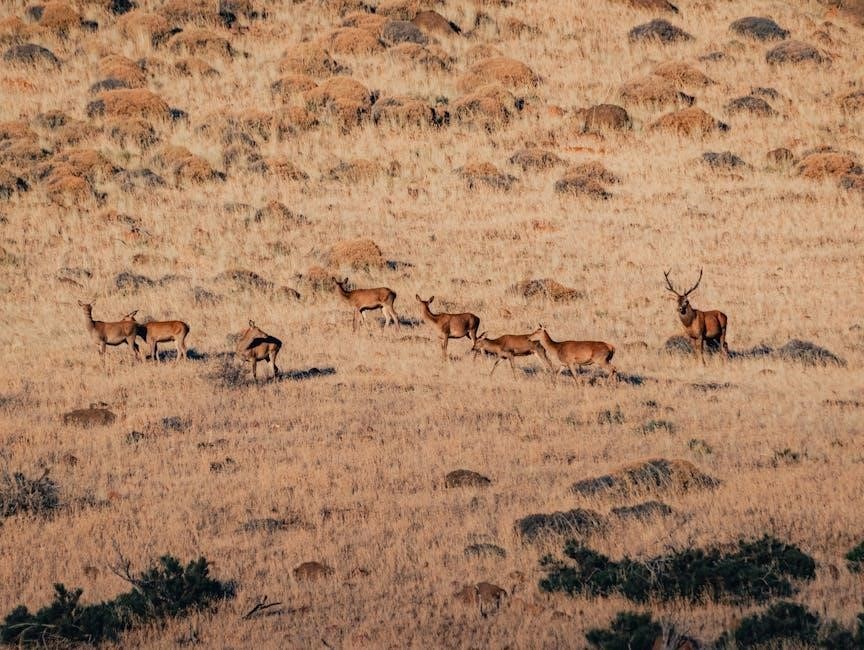
Top Locations for Mule Deer in South Dakota
The Black Hills, Custer State Park, and public lands near the Wyoming border are prime locations for mule deer, offering abundant habitat and excellent hunting opportunities.
8.1 Public Lands and Access Areas
South Dakota offers extensive public lands ideal for mule deer hunting, including the Black Hills National Forest and Buffalo National Grasslands. These areas provide abundant access points, diverse terrain, and prime habitats for mule deer. Public lands are managed to ensure sustainable wildlife populations, making them popular among hunters. Access areas often include trails, camping sites, and scenic overlooks, allowing hunters to explore vast territories. Hunters can utilize GPS and mapping tools to navigate these regions effectively; Public lands in South Dakota remain a cornerstone for mule deer hunting, offering both challenge and opportunity for outdoor enthusiasts.
8.2 Private Ranches and Leases
Private ranches and leases in South Dakota provide exclusive mule deer hunting opportunities, often with managed habitats and reduced hunting pressure. These properties are typically well-maintained, offering prime deer habitats and trophy potential. Guides often have established relationships with landowners, granting access to these private areas. Hunters benefit from controlled access, ensuring a higher quality experience. Private leases may require special permits or arrangements, but they offer unique advantages for those seeking secluded and productive hunting grounds. These areas are highly sought after for their exclusivity and potential for successful mule deer harvests.
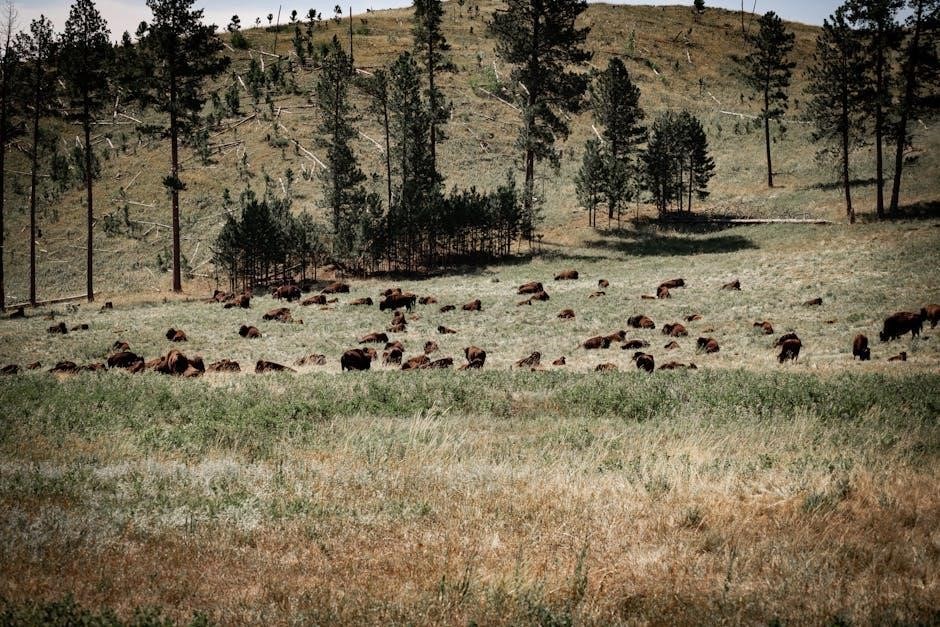
8.3 Historic Migration Routes
South Dakota’s mule deer herds follow historic migration routes between summer and winter habitats, shaped by centuries of adaptation to the state’s diverse landscapes. These routes often align with river valleys, ridges, and natural corridors, providing predictable patterns for hunters. Guides, using their knowledge to position hunters in key areas during peak movement periods. Understanding these routes is crucial for intercepting deer, especially during seasonal transitions. Conservation efforts aim to protect these corridors, ensuring the sustainability of mule deer populations and their timeless migration patterns, which remain a cornerstone of South Dakota’s hunting heritage.
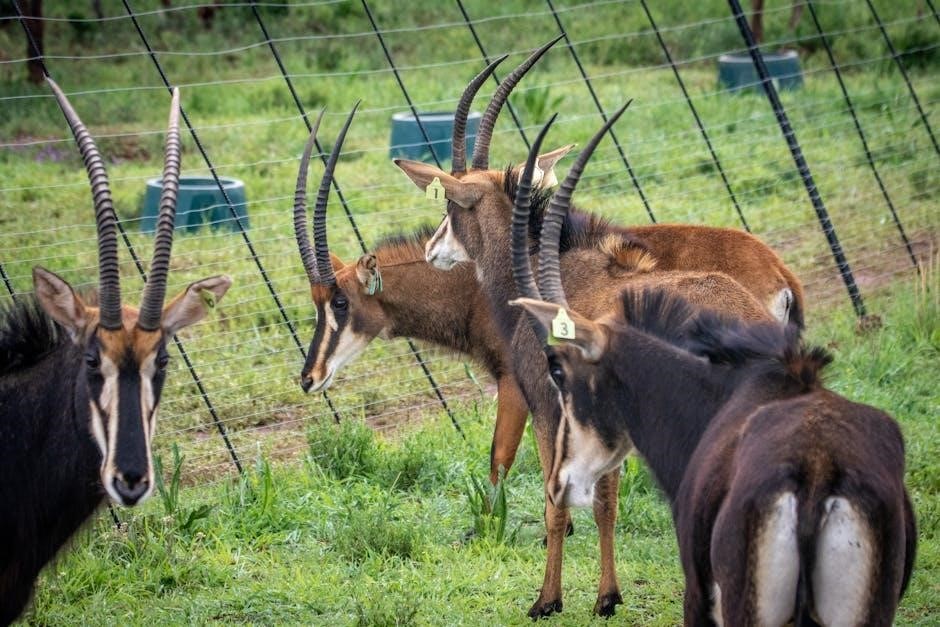
Ethics and Conservation in Mule Deer Hunting
Ethical hunting practices, such as fair chase and responsible harvesting, are crucial for conserving South Dakota’s mule deer populations and maintaining healthy habitats for future generations.
9.1 Fair Chase and Sportsmanship
Fair chase and sportsmanship are cornerstones of ethical hunting in South Dakota. Hunters must ensure that deer have a reasonable chance of escape, avoiding unfair advantages. This principle promotes respect for wildlife and the hunting tradition. Sportsmanship involves honesty, integrity, and adherence to local regulations, fostering a positive image of hunters. By upholding these values, hunters contribute to the conservation of mule deer and the sustainability of the sport for future generations. Ethical practices not only honor the animals but also strengthen the hunting community’s commitment to responsible stewardship.
9.2 Habitat Preservation Efforts
Habitat preservation is vital for maintaining healthy mule deer populations in South Dakota. Guides and hunters often collaborate with conservation organizations to protect and restore natural habitats. Public and private lands are managed to ensure adequate food sources, cover, and water for deer. Initiatives like reforestation, grassland restoration, and access restrictions help maintain balanced ecosystems. These efforts not only benefit mule deer but also support biodiversity and ecological health. By prioritizing habitat conservation, South Dakota ensures sustainable hunting opportunities and preserves the natural beauty of its landscapes for future generations.
9.3 Role of Hunters in Wildlife Management
Hunters play a crucial role in wildlife management by contributing to conservation efforts and maintaining balanced ecosystems. Through license fees and excise taxes, hunters fund habitat restoration and wildlife research. Ethical hunting practices ensure sustainable deer populations, while data collected from harvested animals aids in management decisions. Hunters also help control deer numbers, reducing habitat overgrazing and preventing human-wildlife conflicts. Their participation in voluntary surveys and reporting programs provides valuable insights for biologists. By adhering to regulations and promoting fair chase, hunters support the long-term health of mule deer populations and South Dakota’s natural resources.
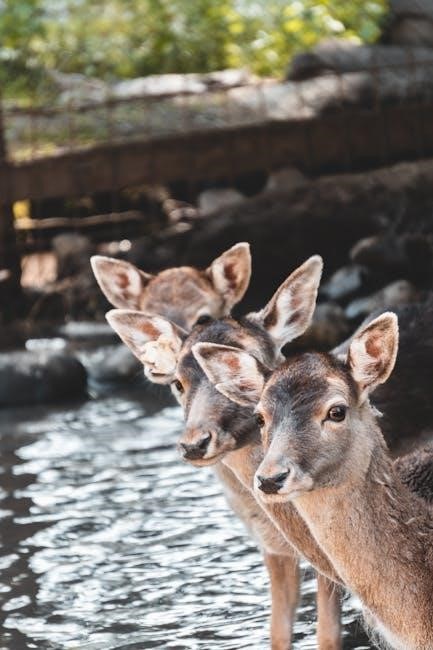
Post-Hunt Processing and Care
Proper field dressing and transport ensure meat quality. Expert taxidermy preserves trophies, while meat processing provides sustainable use of the harvest. Legal and safety standards are crucial.
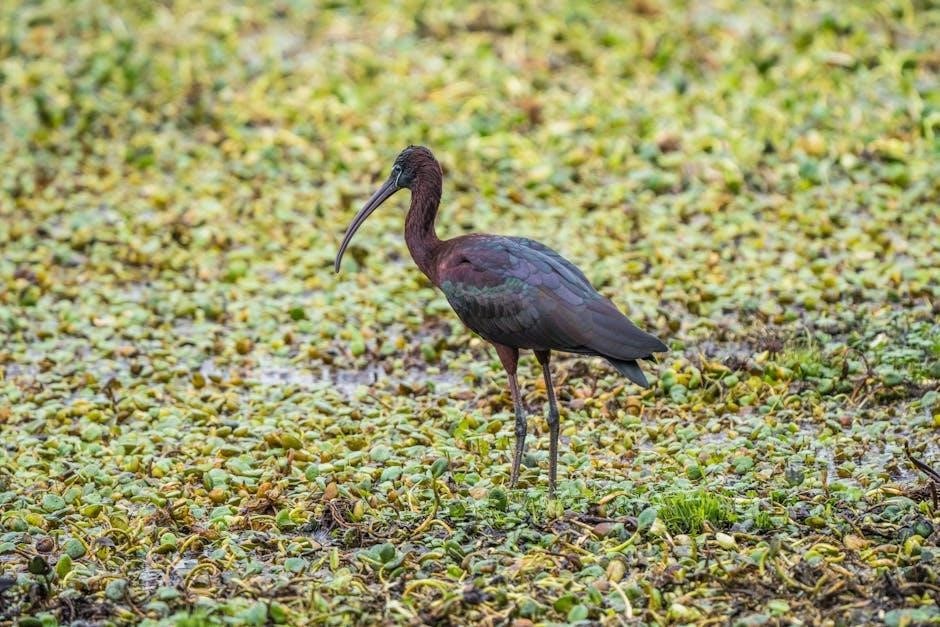
10.1 Field Dressing and Transport
Proper field dressing is crucial to prevent spoilage and maintain meat quality. Guides instruct hunters on quick, clean techniques to remove organs and cool the carcass. Transporting the deer requires careful handling to avoid contamination and damage. Using appropriate equipment, such as game carts or sleds, ensures safe relocation to processing areas. Keeping the carcass cool, often with ice, is vital to preserve quality. South Dakota mule deer guides emphasize adherence to regulations and ethical practices during post-hunt procedures, ensuring a respectful and efficient process from field to table.
10.2 Taxidermy and Meat Processing
South Dakota mule deer guides often collaborate with professional taxidermists to ensure high-quality mounts that capture the buck’s natural beauty. For those interested in preserving their trophy, guides recommend reputable services that deliver lifelike results. Meanwhile, meat processing is handled with care, with guides connecting hunters tolocal butchers who specialize in deer. They ensure the meat is expertly harvested, packaged, and prepared for consumption or jerky; This comprehensive approach respects the animal and maximizes the hunting experience, adhering to ethical practices and regulations throughout the process.
10.4 Legal and Safety Considerations
Legal compliance is crucial for a successful mule deer hunt in South Dakota. Hunters must obtain proper licenses and permits, adhering to state regulations. Safety measures include proper firearm handling, wearing blaze orange, and ensuring ethical practices. Guides emphasize responsible hunting to avoid accidents and ensure sustainable wildlife management. Hunters must also familiarize themselves with private property rights and public access areas. Ethical considerations, such as fair chase and minimizing waste, are integral to maintaining South Dakota’s hunting traditions. Always follow local laws and guidelines to respect the environment and wildlife.